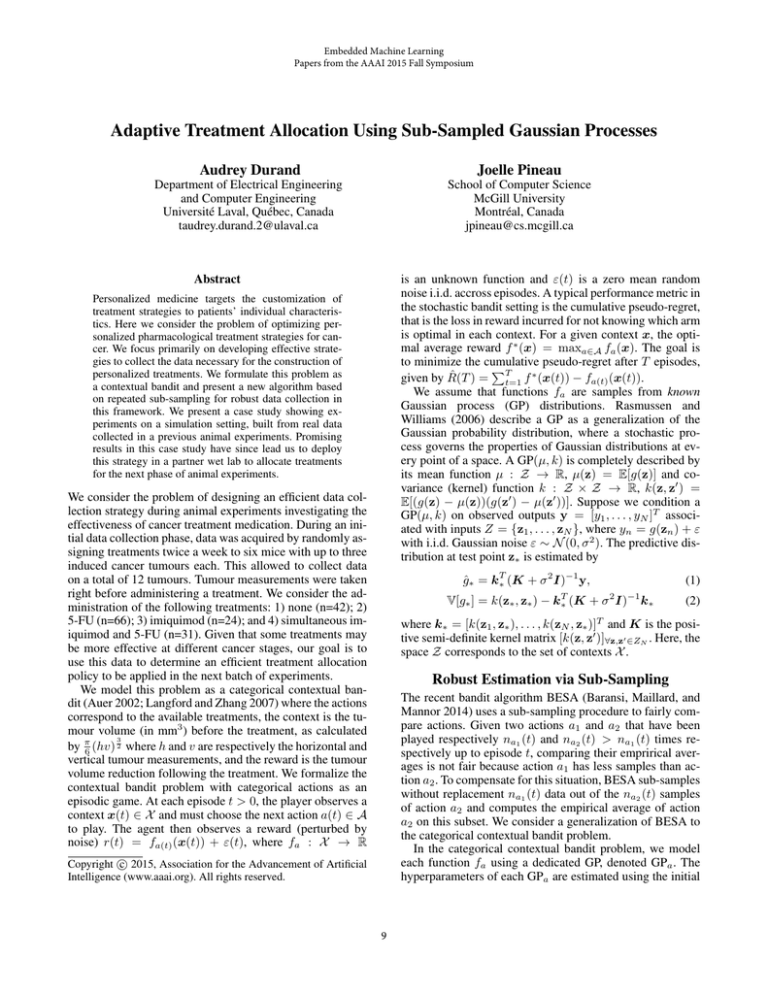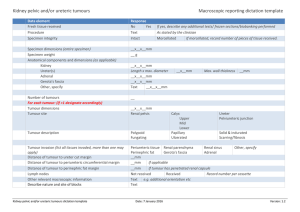
Embedded Machine Learning
Papers from the AAAI 2015 Fall Symposium
Adaptive Treatment Allocation Using Sub-Sampled Gaussian Processes
Audrey Durand
Joelle Pineau
Department of Electrical Engineering
and Computer Engineering
Université Laval, Québec, Canada
taudrey.durand.2@ulaval.ca
School of Computer Science
McGill University
Montréal, Canada
jpineau@cs.mcgill.ca
is an unknown function and ε(t) is a zero mean random
noise i.i.d. accross episodes. A typical performance metric in
the stochastic bandit setting is the cumulative pseudo-regret,
that is the loss in reward incurred for not knowing which arm
is optimal in each context. For a given context x, the optimal average reward f ∗ (x) = maxa∈A fa (x). The goal is
to minimize the cumulative pseudo-regret after T episodes,
PT
given by R̂(T ) = t=1 f ∗ (x(t)) − fa(t) (x(t)).
We assume that functions fa are samples from known
Gaussian process (GP) distributions. Rasmussen and
Williams (2006) describe a GP as a generalization of the
Gaussian probability distribution, where a stochastic process governs the properties of Gaussian distributions at every point of a space. A GP(µ, k) is completely described by
its mean function µ : Z → R, µ(z) = E[g(z)] and covariance (kernel) function k : Z × Z → R, k(z, z0 ) =
E[(g(z) − µ(z))(g(z0 ) − µ(z0 ))]. Suppose we condition a
GP(µ, k) on observed outputs y = [y1 , . . . , yN ]T associated with inputs Z = {z1 , . . . , zN }, where yn = g(zn ) + ε
with i.i.d. Gaussian noise ε ∼ N (0, σ 2 ). The predictive distribution at test point z∗ is estimated by
Abstract
Personalized medicine targets the customization of
treatment strategies to patients’ individual characteristics. Here we consider the problem of optimizing personalized pharmacological treatment strategies for cancer. We focus primarily on developing effective strategies to collect the data necessary for the construction of
personalized treatments. We formulate this problem as
a contextual bandit and present a new algorithm based
on repeated sub-sampling for robust data collection in
this framework. We present a case study showing experiments on a simulation setting, built from real data
collected in a previous animal experiments. Promising
results in this case study have since lead us to deploy
this strategy in a partner wet lab to allocate treatments
for the next phase of animal experiments.
We consider the problem of designing an efficient data collection strategy during animal experiments investigating the
effectiveness of cancer treatment medication. During an initial data collection phase, data was acquired by randomly assigning treatments twice a week to six mice with up to three
induced cancer tumours each. This allowed to collect data
on a total of 12 tumours. Tumour measurements were taken
right before administering a treatment. We consider the administration of the following treatments: 1) none (n=42); 2)
5-FU (n=66); 3) imiquimod (n=24); and 4) simultaneous imiquimod and 5-FU (n=31). Given that some treatments may
be more effective at different cancer stages, our goal is to
use this data to determine an efficient treatment allocation
policy to be applied in the next batch of experiments.
We model this problem as a categorical contextual bandit (Auer 2002; Langford and Zhang 2007) where the actions
correspond to the available treatments, the context is the tumour volume (in mm3 ) before the treatment, as calculated
3
by π6 (hv) 2 where h and v are respectively the horizontal and
vertical tumour measurements, and the reward is the tumour
volume reduction following the treatment. We formalize the
contextual bandit problem with categorical actions as an
episodic game. At each episode t > 0, the player observes a
context x(t) ∈ X and must choose the next action a(t) ∈ A
to play. The agent then observes a reward (perturbed by
noise) r(t) = fa(t) (x(t)) + ε(t), where fa : X → R
ĝ∗ = kT∗ (K + σ 2 I)−1 y,
V[g∗ ] = k(z∗ , z∗ ) −
kT∗ (K
(1)
2
+ σ I)
−1
k∗
(2)
where k∗ = [k(z1 , z∗ ), . . . , k(zN , z∗ )]T and K is the positive semi-definite kernel matrix [k(z, z0 )]∀z,z0 ∈ZN . Here, the
space Z corresponds to the set of contexts X .
Robust Estimation via Sub-Sampling
The recent bandit algorithm BESA (Baransi, Maillard, and
Mannor 2014) uses a sub-sampling procedure to fairly compare actions. Given two actions a1 and a2 that have been
played respectively na1 (t) and na2 (t) > na1 (t) times respectively up to episode t, comparing their emprirical averages is not fair because action a1 has less samples than action a2 . To compensate for this situation, BESA sub-samples
without replacement na1 (t) data out of the na2 (t) samples
of action a2 and computes the empirical average of action
a2 on this subset. We consider a generalization of BESA to
the categorical contextual bandit problem.
In the categorical contextual bandit problem, we model
each function fa using a dedicated GP, denoted GPa . The
hyperparameters of each GPa are estimated using the initial
c 2015, Association for the Advancement of Artificial
Copyright Intelligence (www.aaai.org). All rights reserved.
9
100
Volume reduction
Volume reduction
available data (Krause and Ong 2011). When selecting one
of two actions a1 and a2 , a natural way of proceeding is to
base the decision upon the posterior distributions of their reward functions by conditioning the GPs on their respective
history of observations. Following the idea of BESA, this
would not be fair because they might not have the same number of samples. To compensate, we propose to compute the
posterior distribution by conditioning only on a sub-sample
(without replacement) of the available samples, as shown by
Algorithm 1. Similar to BESA, the algorithm can easily be
extended to multiple arms by organizing a pair-wise tournament between randomly permuted arms (Baransi, Maillard,
and Mannor 2014).
50
0
−50
−100
1
10
2
100
50
0
−50
−100
Volume reduction
Volume reduction
(b) 5-FU
100
50
0
−50
−100
1
10
2
10
Tumour volume
(a) None
Algorithm 1 Sub-sampled GP for a contextual bandit with
two categorical actions
Require: Actions a1 and a2 associated with Gaussian processes GPa1 and GPa2 , the number of times na (t) that
action a has been played up to episode t, the history
of observations Da (t) associated with action a up to
episode t, and the context x(t) received at episode t.
1: n(t) = mina∈{a1 ,a2 } na (t)
2: Uniformely sample n(t) observations without replacement from Da1 (t) and Da2 (t) as Sa1 (t) and Sa2 (t), respectively.
3: Define fˆa1 (t) and fˆa2 (t) as the posterior means of
GPa1 and GPa2 , respectively conditioned on observations Sa1 (t) and Sa2 (t), and evaluated at test point x(t).
4: Choose a(t) = argmaxa∈{a1 ,a2 } fˆa (t), break tie by
choosing a(t) = argmina∈{a1 ,a2 } na (t).
5: Play a(t) and observe r(t).
1
10
10
Tumour volume
2
100
50
0
−50
−100
1
10
10
Tumour volume
2
10
Tumour volume
(c) Imiquimod
(d) 5-FU+Imiquimod
% of plays
Figure 1: Experimental models of average reward functions
using polynomial regression and linear noise (gray area).
100
100
100
80
80
80
60
60
60
40
40
40
20
0
20
1
10
2
10
Tumour volume
(a) Sub-sampling
0
20
1
10
2
10
Tumour volume
(b) CGP-UCB
0
1
10
2
10
Tumour volume
(c) Thompson
Figure 2: Initial policies as probability of administering no
treatement (dark blue), 5-FU (green), imiquimod (red), or
5-FU+imiquimod (light blue) given the context.
Experiments
On each episode, a tumour volume is sampled from the exponential distribution λe−λ(x−γ) with γ = 3.42 and scale
1/λ = 66.88, fitted on the distribution of the available contexts. Tumour reductions are modelled using cubic regression on available data and noise is modelled by linear regression on the standard deviations of available data from
the cubic model, as shown by Figure 1. Red indicates that
the treatment is optimal (it has the largest expected value)
in this context. A negative reduction indicates a grow. The
logarithmic scale emphasizes the expected reward functions
for small tumours, as they are more frequent than large tumours. This setting raises an important new challenge: the
noise is not constant over the space of contexts. Moreover,
the noise increases with the tumour volume, and so is the
sub-optimality gap. This situation is especially hard on regret cumulation as each mistake leads to more regret and
mistakes are more likely to occur when it is noisy.
We compare the sub-sampling approach based on BESA
with two other approaches for (non-linear) contextual bandits using GPs: CGP-UCB (Krause and Ong 2011) and
Thompson sampling (Thompson 1933). All approaches use
squared exponential kernels. Experiments are conducted
over T = 2 000 episodes, for 20 runs.
Figure 2 shows the initial recommended policies (using only the available data). Being randomized, the subsampling approach and Thompson recommend every treatments according to their estimated probabiblity of being optimal, while deterministic CGP-UCB recommends a single
treatment for each context. The policy recommended by the
sub-sampling is similar to Thompson, with emphasis on 5FU for low tumour volume. Though this allocation policy
does not yet match the optimal regions (red) of the average reward functions (Fig. 1), Figure 3a shows that the subsampling approach adapts faster to the model and at a lower
regret cost than the other methods. In order to validate that
the results not only due to a favorable modelling, experiments are also conducted using average rewards functions
obtained with linear regression (instead of cubic regression).
Figure 3b shows the average cumulative pseudo-regret with
this linear model. One observes that, if Thompson performs
better than with the polynomial model, the sub-sampling approach still outperforms all alternatives.
10
(a) Polynomial model
Pseudo-regret
Pseudo-regret
1e4
1.6
1.4
1.2
1.0
0.8
0.6
0.4
0.2
0.0
0.0 0.5 1.0 1.5 2.0
Tumours 1e3
1e4
1.6
1.4
1.2
1.0
0.8
0.6
0.4
0.2
0.0
0.0 0.5 1.0 1.5 2.0
Tumours 1e3
(b) Linear model
Figure 3: Cumulative pseudo-regret using sub-sampling
(red), CGP-UCB (dash), and Thompson sampling (dot).
Conclusion
We presented a problem that highlights several challenges
of real-world applications such as how to deal with low
amount of initial data and high noise. We formulate it as
a (non-linear) contextual bandit and propose a new solution approach based on an easy-to-implement sub-sampling
approach that requires few parameters. This approach is
strongly supported by our experimental results in the simulation case. On the basis of these findings, we have since
deployed the strategy in a partner wet lab to collect the next
phase of experimental data. Results should be available in
the coming months.
Acknowledgments We would like to thank Georgios
Mitsis (McGill University), Katerina Strati (University of
Cyprus), Demetris Iacovides (University of Cyprus), and
Charis Achilleos (University of Cyprus) for providing the
data used in this work. This work was supported through
funding from NSERC (Canada) and REPARTI-FRQNT
(Québec).
References
Auer, P. 2002. Using confidence bounds for exploitationexploration trade-offs. Journal of Machine Learning Research 3:397–422.
Baransi, A.; Maillard, O.-A.; and Mannor, S. 2014. Subsampling for multi-armed bandits. In Proceedings of the
European Conference on Machine Learning (ECML).
Krause, A., and Ong, C. S. 2011. Contextual Gaussian process bandit optimization. In Advances in Neural Information
Processing Systems 24 (NIPS), 2447–2455.
Langford, J., and Zhang, T. 2007. The epoch-greedy algorithm for contextual multi-armed bandits. In Advances in
Neural Information Processing Systems 21 (NIPS), 1096–
1104.
Rasmussen, C. E., and Williams, C. K. I. 2006. Gaussian
processes for machine learning. MIT Press 2(4).
Thompson, W. R. 1933. On the likelihood that one unknown
probability exceeds another in view of the evidence of two
samples. Biometrika Trust 25(3):285–294.
11





